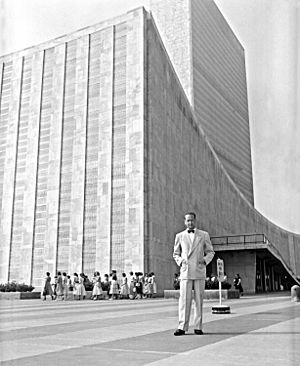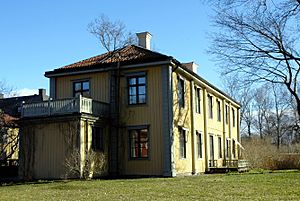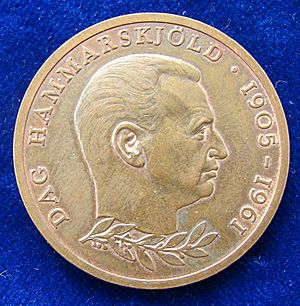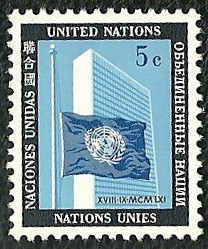Dag Hammarskjöld facts for kids
Quick facts for kids
Dag Hammarskjöld
|
|
|---|---|

Hammarskjöld in the 1950s
|
|
| Secretary-General of the United Nations | |
| In office 10 April 1953 – 18 September 1961 |
|
| Preceded by | Trygve Lie |
| Succeeded by | U Thant |
| Personal details | |
| Born |
Dag Hjalmar Agne Carl Hammarskjöld
29 July 1905 Jönköping, Sweden, United Kingdoms of Sweden and Norway |
| Died | 18 September 1961 (aged 56) Ndola, Northern Rhodesia, Federation of Rhodesia and Nyasaland (now Zambia) |
| Cause of death | Aeroplane crash |
| Nationality | Swedish |
| Political party | Independent |
| Parents |
|
| Alma mater | Uppsala University Stockholm University |
| Signature | |
Dag Hammarskjöld (born July 29, 1905 – died September 18, 1961) was a Swedish economist and diplomat. He became the second leader of the United Nations, called the Secretary-General, in April 1953. He served until he died in a plane crash in September 1961.
Hammarskjöld was only 47 years old when he was chosen for the job. This makes him the youngest person ever to hold this important position. During his time as Secretary-General, he worked hard to make the UN stronger. He wanted the UN to be better at helping solve problems around the world.
He helped create the first UN peacekeeping forces. These forces were sent to places like Egypt and the Congo to help keep the peace. He also personally stepped in to help solve big disagreements between countries. Hammarskjöld is still seen as a very skilled diplomat and leader. He even received the Nobel Peace Prize after his death for his efforts to bring peace. Many people believe he was one of the best UN Secretaries-General ever.
Contents
Early Life and Learning
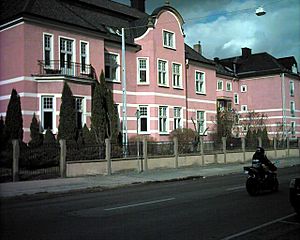
Dag Hammarskjöld was born in Jönköping, Sweden. He came from a noble family. He spent most of his childhood in Uppsala, where his family lived in Uppsala Castle. His father, Hjalmar Hammarskjöld, was the Prime Minister of Sweden from 1914 to 1917. Dag was the youngest of four sons.
He went to school at Katedralskolan and then to Uppsala University. By 1930, he had earned degrees in philosophy and law. Even before finishing his law degree, he started working as an assistant for a government committee on unemployment.
His Career Before the UN
From 1930 to 1934, Hammarskjöld worked for a government committee that dealt with unemployment. During this time, he also wrote his economics paper and earned a doctorate degree from Stockholm University. In 1936, he started working at Sweden's central bank, the Riksbank. He later became the chairman of the Riksbank's General Council from 1941 to 1948.
Hammarskjöld became a very successful public servant in Sweden. He worked in the Ministry of Finance and later for the Ministry of Foreign Affairs. He also served as a minister in the government.
He helped plan how the government would fix economic problems after World War II. He also helped set up the Marshall Plan, which was a program to help rebuild Europe. Even though he worked with a government led by the Social Democrats, he never officially joined any political party.
In 1951, Hammarskjöld was part of the Swedish team at the United Nations General Assembly meeting in Paris. The next year, he became the leader of the Swedish team at the General Assembly in New York.
Becoming UN Secretary-General
How He Was Chosen
In November 1952, the first UN Secretary-General, Trygve Lie, said he would step down. For several months, different countries tried to agree on who should take his place. It was a difficult decision.
On March 30, 1953, a French diplomat suggested four people, including Hammarskjöld. At first, many countries, especially the Soviet Union, thought Hammarskjöld would be a quiet leader who would not get involved in big political fights. They thought he was "harmless."
The news of his nomination came as a big surprise to many. On April 1, 1953, Hammarskjöld was woken up by a journalist telling him the news. He thought it was an April Fool's Day joke! But after a few more calls, he realized it was true. After talking with his family and the Swedish government, he decided to accept the important job.
On April 7, 1953, the UN General Assembly voted to make Dag Hammarskjöld the new Secretary-General. He officially started his job on April 10, 1953. He was so well-liked that he was chosen again for another term in 1957.
His Time as Leader
When Hammarskjöld became Secretary-General, he immediately tried to connect with his staff. He visited every UN department to shake hands with workers. He also ate in the cafeteria often and let everyone use the private elevator that was meant only for him. He wanted to make the UN a better place to work. He even helped create a special meditation room at the UN headquarters. This room was for people to find quiet time, no matter their beliefs.
During his time, Hammarskjöld worked to improve relations between Israel and the Arab countries. He also visited China in 1955 to help release 11 American pilots who were captured during the Korean War. In 1956, he helped create the United Nations Emergency Force and played a key role in solving the Suez Crisis.
In 1960, the country of Congo (now DR Congo) asked the UN for help. There was a big crisis happening there. Hammarskjöld went to Congo four times to try and help. He sent a UN peacekeeping force to keep the peace. However, the Soviet Union disagreed with some of his decisions. They even asked him to resign.
The UN sent almost 20,000 peacekeepers to Congo. Hammarskjöld's actions in Congo caused some disagreement among countries. In the end, only the United States and Belgium fully supported his actions.
His Death
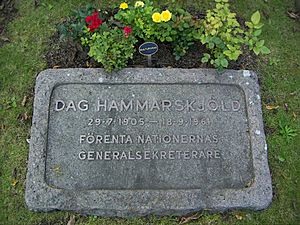
On September 18, 1961, Hammarskjöld was flying to meet with troops in Congo to try and arrange a cease-fire. His plane, a Douglas DC-6, crashed near Ndola, which was then in Northern Rhodesia (now Zambia). Hammarskjöld and all 15 other people on board died in the crash. His death caused a big problem for the UN because there was no clear plan for who should take over.
The exact reasons for the crash are still not fully known. A first investigation in 1962 said it was pilot error. But later UN investigations could not figure out the cause. Some evidence suggests the plane might have been shot down. There have been many theories and investigations over the years. Some documents have suggested that spy agencies or mining companies might have been involved. This is because Hammarskjöld's work in Congo went against the interests of some powerful groups who wanted control over the country's rich minerals.
In 2019, a documentary film called Cold Case Hammarskjöld suggested that a Belgian pilot might have shot down the plane. However, the pilot's family said he was not involved. Investigations are still ongoing, and new information continues to be found.
Hammarskjöld's will stated that his personal papers should go to the National Library of Sweden.
His Personal Life

Dag Hammarskjöld was a very thoughtful person. His only book, Vägmärken (which means Markings or Waymarks), was published after his death in 1963. It is a collection of his diary entries and thoughts. The book starts when he was 20 years old and ends just a month before he died. This diary was found in his New York home.
The famous English poet W. H. Auden, who was a friend of Hammarskjöld's, wrote the introduction to Markings. Many people have praised the book for its deep spiritual meaning and how it shows Hammarskjöld's personal journey while he was working to achieve world peace.
Hammarskjöld was also interested in philosophy and spiritual ideas. He was even translating a book by the philosopher Martin Buber when he died. The Evangelical Lutheran Church in America remembers Hammarskjöld on September 18, the day he died, as someone who helped renew society.
His Legacy
Awards and Honors
- Honorary Degrees: Many universities around the world gave Hammarskjöld special honorary degrees. These included Carleton University in Canada, Oxford University in the UK, and several famous universities in the United States like Harvard, Yale, and Princeton.
- Nobel Peace Prize: He was given the Nobel Peace Prize after his death in 1961. He is the only person to have received this award posthumously.
What People Thought of Him
- John F. Kennedy: The U.S. President John F. Kennedy said after Hammarskjöld's death, "I realize now that in comparison to him, I am a small man. He was the greatest statesman of our century."
- The Financial Times: In 2011, The Financial Times newspaper wrote that Hammarskjöld is still the standard by which all later UN Secretaries-General are judged.
Places Named After Him
Many buildings, schools, and places are named after Dag Hammarskjöld:
- Dag Hammarskjöld Library: The library at the UN headquarters in New York was named after him in 1961, shortly after his death.
- Schools: There are several schools named after him, including Hammarskjold High School in Canada and Hammarskjold Middle Schools in New Jersey and Connecticut. There is also a Dag Hammarskjöld Elementary School in Brooklyn, New York.
- Streets and Plazas: There are streets named Hammarskjöldring in Germany and a public park called Dag Hammarskjöld Plaza near the UN headquarters in New York City.
Other Ways He Is Remembered
- Dag Hammarskjöld Foundation: This foundation was created in 1962 in Sweden to honor his memory.
- Dag Hammarskjöld Medal: In 1997, the UN created the Dag Hammarskjöld Medal. This medal is given to honor people who have lost their lives while serving in UN peacekeeping missions.
- Prize in Peace and Conflict Studies: Colgate University gives an annual prize to a student for excellent work in peace and conflict studies, named after Hammarskjöld.
- Postage Stamps: Many countries have issued postage stamps to remember Hammarskjöld.
- Swedish Banknote: In 2011, Sweden's central bank announced that Hammarskjöld's picture would be on the 1000-kronor banknote, which is the highest value banknote in Sweden.
In Music and Movies
The composer Malcolm Williamson wrote a piece of music called Hammarskjöld Portrait in 1974. The words for the music came from Hammarskjöld's book Vägmärken.
In the 2016 movie The Siege of Jadotville, which is about the events in the Congo Crisis, Hammarskjöld is played by the Swedish actor Mikael Persbrandt. In the movie, his plane is shown being shot down.
See also
 In Spanish: Dag Hammarskjöld para niños
In Spanish: Dag Hammarskjöld para niños
- List of unsolved deaths


